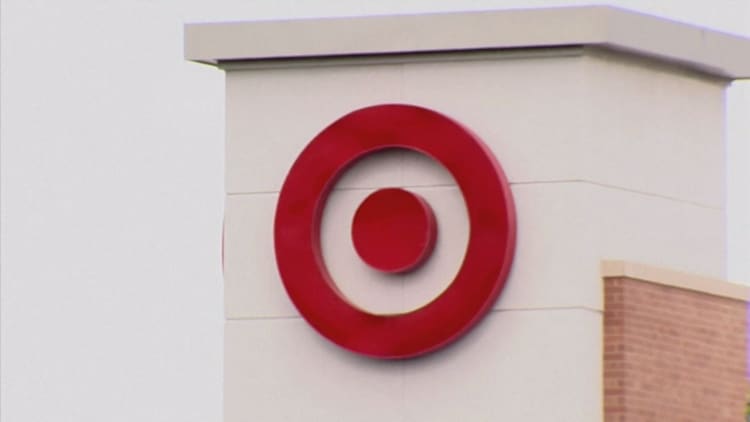
With more shoppers heading to its stores and sales improving, Target boosted its second-quarter earnings forecast Thursday, sending the retailer's stock higher.
Target said it now expects a "modest increase" in second-quarter comparable-store sales, a metric closely watched by Wall Street for retail stocks. Previously, the discount retailer had predicted that same-store sales would be negative, as they have been for four consecutive quarters.
Shares of Target jumped more than 5 percent Thursday. Other retail stocks also were trading higher on the news. Wal-Mart gained 1.5 percent, Kohl's was up 4.8 percent, and Macy's climbed more than 5 percent.
The SPDR S&P Retail ETF rose 2.4 percent, putting it on pace for its best day of the year, back to Nov. 10, when it gained nearly 2.7 percent. If the momentum holds, it would be its third straight daily gain.
Target has been seen as straggling behind some of its peers, with Amazon poised to snag grocery chain Whole Foods and rival Wal-Mart beefing up its digital operations by buying Jet.com and acquiring smaller apparel brands like Bonobos and Modcloth.
Meanwhile, Target has remained focused on its plan to inject $7 billion into its business over the next three years. Some may view the improved forecast as a sign those investing efforts are helping Target's performance.
"Overall, we find the guidance update notable, particularly in light of worsening trends across the majority of retailers," said Mark Astrachan, an analyst at Stifel. "We believe the positive guidance revision indicates early success of the company's investments into the business, including in price, labor, and digital."
During the first quarter, there were hints that Target's trends were improving, Kantar Retail analyst Leon Nicholas told CNBC. "You also have to consider they had set the bar pretty low. ... They had said to look at this year like a transition year."
Target said it now expects its second-quarter earnings to fall above the high end of its previous forecast range, which was 95 cents to $1.15 a share. This was helped by a net tax effect related to its global sourcing operations, Target added.
"Following better-than-expected results in the first quarter, we've seen additional, broad-based improvement in traffic and category sales trends in the second quarter, despite continued challenges in the competitive environment," Target CEO Brian Cornell said in a statement.
"The launch of Cloud Island in May was a success, and our team will be rolling out four more exclusive brands across Home and Apparel in the next few months, in support of our plan to launch 12 new brands by the end of 2018."
According to Target spokeswoman Erin Conroy, the company has seen "broad-based improvements across the business."
"There's not one single moment in time, one single category or aspect of the business or the quarter that is driving the improvement," she said.
The problem for Target lately has been waning foot traffic at its stores, not so much web traffic, Kantar Retail's Nicholas said.
"If I look at what they've been doing [in stores], one greater focus is on private brands, like Cat & Jack," he said.
Target has hoped these exclusive lines will draw in more shoppers, who won't be able to find that merchandise elsewhere. But analysts remain concerned about how Target will turn around its grocery business, which arguably takes up a lot of real estate in stores.
"Come fall, when Target launches new brands, it should bring excitement back to stores," Nicholas said. "But it doesn't quite solve some of the fundamentals. It doesn't solve the ongoing grocery issue."
Target's apparel business performed "reasonably," especially in kidswear, said Neil Saunders, managing director of GlobalData Retail, citing his firm's own research. "Homewares has also picked up a bit, and beauty has been strong."
However, Saunders agreed Target's grocery business remains the laggard, with sales still "sluggish."
Target also said Thursday it was pleased with initial results from launching Target Restock, a next-day home delivery service it is testing in Minneapolis-Saint Paul.
Target Restock is most similar to Amazon's Prime Pantry, where shoppers can pick and choose from "everyday essentials" online and fill a box to be sent speedily to one's household. Both programs remain in the early phases, though.
"Severe headwinds remain for Target in the form of Amazon and the fact Target still has work to do in terms of lowering prices, remodeling stores, opening and integrating their smaller store format within Target's ecosystem, gaining traction with their new private-label brands, improving the digital experience and finding a way to create a viable grocery experience for customers," said Brittain Ladd, a strategy and supply chain consultant who also once worked on the global expansion of AmazonFresh.
"The concern I have is that it will become more difficult for Target to perform to Wall Street and customer expectations as they transform," Ladd told CNBC.
"It remains to be seen if Target is actually reconnecting with customers or if Target merely had a better quarter than expected."
Target will report second-quarter earnings results on Aug. 16.
WATCH: Target raises second-quarter forecast

Correction: This article has been updated to reflect that Brittain Ladd worked on the global expansion of AmazonFresh.


